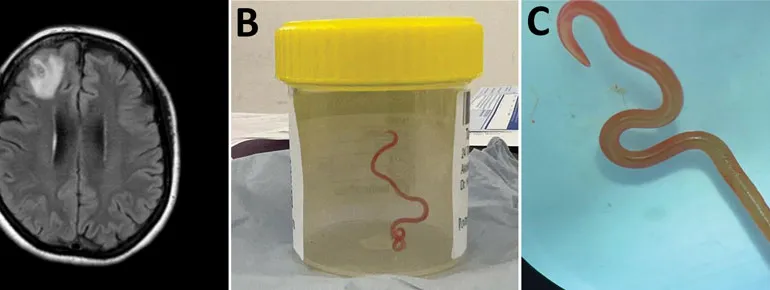Live Parasitic Worm Found in Australian Woman’s Brain in World First
SCIENCE, 4 Sep 2023
Al Jazeera - TRANSCEND Media Service
29 Aug 2023 – A live parasitic worm has been found inside the brain of a 64-year-old Australian woman, marking the first case of the infection in humans.
The discovery was made by doctors and researchers at the Australian National University (ANU) and Canberra Hospital after they found a live 8 cm (3.15 inches) roundworm in the woman.
The Ophidascaris robertsi roundworm – whose usual host is a carpet python – was pulled from the patient after brain surgery – alive and wriggling. The worm’s larvae were also suspected to have infected other organs in the woman’s body, including her lungs and liver.
“This is the first-ever human case of Ophidascaris to be described in the world,” Sanjaya Senanayake, an expert on infectious diseases at the ANU and Canberra Hospital said in a statement.
“To our knowledge, this is also the first case to involve the brain of any mammalian species, human or otherwise.
“Normally the larvae from the roundworm are found in small mammals and marsupials, which are eaten by the python, allowing the life cycle to complete itself in the snake.”
The researchers, who published their findings in the Emerging Infectious Diseases journal, said the woman probably picked up the infection from Warrigal greens, a type of native grass, she collected near her home and then cooked.
The grasses are a habitat for pythons who would have shed the parasite’s eggs through their faeces.
Ophidascaris robertsi roundworms are common to carpet pythons and live in a python’s oesophagus and stomach.
Described by ANU as “incredibly resilient”, roundworms can thrive in a wide range of environments.
‘Microscopic larvae’
The researchers say the woman, from the southeastern state of New South Wales, was probably infected from touching the native grass or after eating it.
Canberra Hospital’s director of clinical microbiology and associate professor at the ANU Medical School, Karina Kennedy, said the woman’s symptoms first appeared in January 2021 and, as they worsened over a period of three weeks, she was admitted to hospital.
“She initially developed abdominal pain and diarrhoea, followed by fever, cough and shortness of breath. In retrospect, these symptoms were likely due to migration of roundworm larvae from the bowel and into other organs, such as the liver and the lungs. Respiratory samples and a lung biopsy were performed; however, no parasites were identified in these specimens,” she said.
“At that time, trying to identify the microscopic larvae, which had never previously been identified as causing human infection, was a bit like trying to find a needle in a haystack.”
By 2022, the woman was experiencing forgetfulness and depression, prompting an MRI scan, which showed a lesion in her brain.
When a hospital neurosurgeon investigated, they were shocked to discover the worm, whose identity was later confirmed through parasitology experts.
Senanayake said the case underlined the growing risk of disease passing from animals to humans.
“There have been about 30 new infections in the world in the last 30 years. Of the emerging infections globally, about 75 percent are zoonotic, meaning there has been transmission from the animal world to the human world. This includes coronaviruses,” he said.
“This Ophidascaris infection does not transmit between people, so it won’t cause a pandemic like SARS, COVID-19 or Ebola. However, the snake and parasite are found in other parts of the world, so it is likely that other cases will be recognised in coming years in other countries.”
The woman, who had not recovered fully from a bout of pneumonia before she was infected with the worm, continues to be monitored by specialists.
Go to Original – aljazeera.com
Tags: Brain, Human body, Science, Science and Medicine
DISCLAIMER: The statements, views and opinions expressed in pieces republished here are solely those of the authors and do not necessarily represent those of TMS. In accordance with title 17 U.S.C. section 107, this material is distributed without profit to those who have expressed a prior interest in receiving the included information for research and educational purposes. TMS has no affiliation whatsoever with the originator of this article nor is TMS endorsed or sponsored by the originator. “GO TO ORIGINAL” links are provided as a convenience to our readers and allow for verification of authenticity. However, as originating pages are often updated by their originating host sites, the versions posted may not match the versions our readers view when clicking the “GO TO ORIGINAL” links. This site contains copyrighted material the use of which has not always been specifically authorized by the copyright owner. We are making such material available in our efforts to advance understanding of environmental, political, human rights, economic, democracy, scientific, and social justice issues, etc. We believe this constitutes a ‘fair use’ of any such copyrighted material as provided for in section 107 of the US Copyright Law. In accordance with Title 17 U.S.C. Section 107, the material on this site is distributed without profit to those who have expressed a prior interest in receiving the included information for research and educational purposes. For more information go to: http://www.law.cornell.edu/uscode/17/107.shtml. If you wish to use copyrighted material from this site for purposes of your own that go beyond ‘fair use’, you must obtain permission from the copyright owner.
